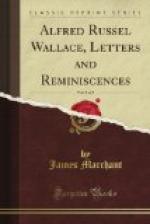My dear Poulton,—It is very interesting to me to see how very generally the facts are in accordance with theory, and I am only surprised that the exceptions and irregularities are not more numerous than they are found to be. The only difficult case, that of D. euphorbiae, is due probably to incomplete knowledge. Are lizards and sea-birds the only, or even the chief, possible enemies of the species? They evidently do not prevent its coming to maturity in considerable abundance, and it is therefore no doubt preserved from its chief enemies during its various stages of growth.
The only point on which I differ from you—as you know—is your acceptance, as proved, of the theory of sexual colour selection, and your speaking of insects as having a sense of “the beautiful” in colour, as if that were a known fact. But that is a wide question, requiring full discussion.—Yours very faithfully,
ALFRED R. WALLACE.
* * * * *
TO SIR FRANCIS DARWIN
Frith Hill, Godalming. November 20, 1887.
Dear Mr. Darwin,—Many thanks for the copy of your father’s “Life and Letters,” which I shall read with very great interest (as will all the world). I was not aware before that your father had been so distressed—or rather disturbed—by my sending him my essay from Ternate, and I am very glad to feel that his exaggerated sense of honour was quite needless so far as I was concerned, and that the incident did not in any way disturb our friendly relations. I always felt, and feel still, that people generally give me far too much credit for my mere sketch of the theory—so very small an affair as compared with the vast foundation of fact and experiment on which your father worked.—Believe me yours very faithfully,
ALFRED R. WALLACE.
* * * * *
TO MRS. FISHER (nee BUCKLEY)
Frith Hill, Godalming. February 16, 1888.
My dear Mrs. Fisher,—I know nothing of the physiology of ferns and mosses, but as a matter of fact I think they will be found to increase and diminish together all over the world. Both like moist, equable climates and shade, and are therefore both so abundant in oceanic islands, and in the high regions of the tropics.
I am inclined to think that the reason ferns have persisted so long in competition with flowering plants is the fact that they thrive best in shade, flowers best in the light. In our woods and ravines the flowers are mostly spring flowers, which die away just as the foliage of the trees is coming out and the shade deepens; while ferns are often dormant at that time, but grow as the shade increases.
Why tree-ferns should not grow in cold countries I know not, except that it may be the winds are too violent and would tear all the fronds off before the spores were ripe. Everywhere they grow in ravines, or in forests where they are sheltered, even in the tropics. And they are not generally abundant, but grow in particular zones only. In all the Amazon valley I don’t remember ever having seen a tree-fern....




